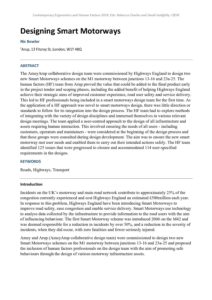| Document | Author Nic Bowler |
| Abstract The AmeyArup collaborative design team were commissioned by Highways England to design two new Smart Motorways schemes on the M1 motorway between junctions 13-16 and 23a-25. The human factors (HF) team from Arup proved the value that could be added to the final product early in the project tender and scoping phases, including the added benefit of helping Highways England achieve their strategic aims of improved customer experience, road user safety and service delivery. This led to HF professionals being included in a smart motorways design team for the first time. As the application of a HF approach was novel to smart motorways design, there was little direction or standards to follow for its integration into the design process. The HF team had to explore methods of integrating with the variety of design disciplines and immersed themselves in various relevant design meetings. The team applied a user-centred approach to the design of all infrastructure and assets requiring human interaction. This involved ensuring the needs of all users - including customers, operators and maintainers - were considered at the beginning of the design process and that these groups were consulted during design development. The aim was to ensure the new smart motorway met user needs and enabled them to carry out their intended actions safely. The HF team identified 125 issues that were progressed to closure and accommodated 114 user-specified requirements in the designs. |

